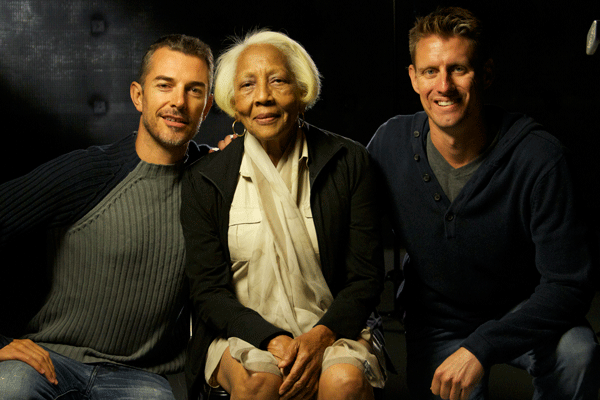
BY SEAN EGAN | Even Doris Payne’s closest friends understand that she is nowhere near the charming, innocent old woman she appears to be on the surface. “Doris is no saint,” says her lifelong friend, Jean. “Her horns are holding her halo up. But she’s 80 years old — come on, give her a break!”
Jean says this as she’s waiting in court to hear a jury’s verdict on whether or not Doris goes to jail. You see, Doris Payne is not only a charismatic, elderly mother of two — she’s also a notorious international jewel thief. Payne is a woman of contradictions, equal parts legend and liar, hero and criminal. In the new documentary “The Life and Crimes of Doris Payne,” directors Matthew Pond and Kirk Marcolina find tension in their attempts to pin down exactly who Doris Payne is, and what she stands for. It’s something of a Sisyphean task — an exercise in scrutinizing the inscrutable.
Doris Payne keeps us guessing what’s real and what’s an enticing lie
As the film begins, Doris is facing some serious jail time for allegedly stealing an expensive ring from a Macy’s. She claims that she never stole anything from the store, despite the fact that the description of the thief’s methods fit her M.O., and the fact that the store possesses (admittedly blurry) footage of the thief who may or may not be Doris. By centering the film around the trial, the filmmakers present an engaging “Did she or didn’t she?” narrative, which also is able to highlight the differences between the Doris of her heyday, and present-day Doris — who struggles to outwit modern technology and the law.
The movie spends a lot of time recounting the decades Doris spent building a name for herself amongst jewel thieves. Using her considerable charms and beauty, and adopting an air of upper class sophistication that belied her roots as a poor southern child from a home with an abusive father, Doris was able to lull jewelry store owners into a false sense of security — which allowed her to rob them blind, repeatedly, and still (according to her) never get caught by authorities walking out of the stores. When all was said and done, she’d stolen over $2 million, hopped across continents and outsmarted all her accomplices and law enforcement agents along the way.
FILM | THE LIFE AND CRIMES OF DORIS PAYNE
Produced & Directed by Matthew Pond & Kirk Marcolina
Through June 10
At Film Forum
209 West Houston St.
(West of Sixth Ave.)
Screenings daily at 12:45, 2:40, 4:30, 6:20, 8:10 & 10:00 p.m.
Visit filmforum.org
Periodically a host of interviewees crop up to play armchair psychologist, theorizing what motivated Doris to steal, by taking into consideration all of her life story. While she was ruthless in order to get ahead, she also had to deal with growing up in the segregated south as a woman of color. Doris herself said she saw her stealing as some kind of revenge for the prejudice that she faced as a black woman in the 1950s-70s. She also used her ill-gotten gains to support her children, and help her mother escape an abusive relationship. On the other hand, the money funded her expensive tastes and trips abroad (to steal more). There’s also the undeniable rush she felt when stealing that indicates something more selfish at play underneath her claims of righteous criminality.
The film is at its most intellectually interesting during these sections — but it fails to dig deeper into the psychology of its subject, to see what makes her tick. Spending more time with Doris’ family would certainly be more enlightening. And the film could definitely have had more cutting insight, by conducting a thorough examination of how racial inequality and sexism shaped the young Doris, as well as the larger effects these factors had on society as a whole.
But then one can’t complain too much, as Payne herself is a fascinating and lively subject. The doc comes to life whenever she’s on screen. She’s everything her critics and admirers say she is: sweet, whip smart, classy, funny — and never to be completely trusted. She is, after all, a criminal who spent years fooling people into believing she something she’s not. This makes Doris tremendous fun to watch, because you’re constantly trying to figure out whether she’s being candid, fudging the truth or telling outright lies in order to build up her legacy or get out of trouble.
While most of these present-day interviews and day-to-day footage are shot in a manner similar to a standard History Channel program, the film nonetheless is able to inject a distinct sense of style into the proceedings. Doris’ anecdotes about past capers are augmented by re-enactments which are all soft-focus and supersaturated color — reminiscent of glamorous Technicolor films of yore, like 1955’s “To Catch a Thief” (amusingly, one of Payne’s favorite films and an inspiration for a particularly daring theft/escape). Combined with the playful, jazzy score that accompanies most of these tales, “The Life and Crimes of Doris Payne” capture a vibrant, nostalgic atmosphere that stands in stark contrast to the more clinical filmmaking.
Overall, this is an entertaining, if slight, documentary about a larger-than-life figure. At its best, the documentary asks audiences to consider what circumstances shaped Doris into the unique individual she is, and challenges them to discern what is real and what’s an enticing lie. That Doris Payne is such a fun, memorable subject is just the cherry on top.

















